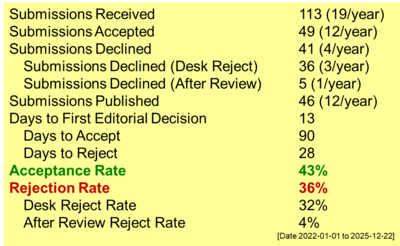Development and Characterization of Gold Nanoparticle-Modified SPCEs for the Electrochemical Sensing
DOI:
https://doi.org/10.55749/ijcs.v4i2.71Keywords:
Cyclic voltammetry, Differential pulse voltammetry, Drop casting, Gold nanoparticles, Screen printed carbon electrodeAbstract
Gold nanoparticles were successfully synthesized by reducing HAuCl4 using jengkol (Archidendron pauciflorum) extract as a reductant. The synthesized gold nanoparticles were characterized by UV–vis spectroscopy and particle size analyzer (PSA). The synthesized gold nanoparticles were deposited on the screen printed carbon electrode (SPCE) substrate using 2 methods, drop casting and differential pulse voltammetry over a potential range of (-1500) mV to 600 mV, scan rate of 100 mV/s for 5 cycles. The surface plasmon resonance (SPR) band of UV– Vis spectrum at 530.7 nm confirmed the presence of gold nanoparticles. The results of Au nanoparticle characterization using PSA show that the size of the Au-NPs formed is 33.5 nm with an optimal HAuCl4 concentration of 0.20 mM. Characterization of gold nano-deposited SPCE was carried out by measuring the peak current of the 1 mM K3Fe(CN)6/K4Fe(CN)6 system in KCl electrolyte solution (0.1 M) using cyclic voltammetry over a potential range of (-500) mV to 1000 mV, scan rate 100 mV/s for 5 cycles. Gold nanoparticles deposited by differential pulse voltammetry showed a higher current response compared to drop casting deposition.
References
Daniel, M.C., & Astruc, D. 2004. Gold nanoparticles: assembly, supramolecular chemistry, quantum-size-related properties, and applications toward biology, catalysis, and nanotechnology. Chem. Rev. 104(1). 293–346. doi: https://doi.org/10.1021/cr030698
Ahmed, S., Ahmad, M., Swami, B. L., & Ikram, S. 2016. A review on plants extract mediated synthesis of silver nanoparticles for antimicrobial applications: A green expertise. J. Adv. Res. 7(1). 17–28. doi: https://doi.org/10.1016/j.jare.2015.02.007
Zhou, Y., Liu, Y., Tang, D., & Niessner, R. 2018. Gold nanoparticle-based signal amplification for biosensing. Trends Anal. Chem. 102. 41–54. doi: https://doi.org/10.1016/j.trac.2018.02.011
Pournaghi-Azar, M.H., & Mehdizadeh, H. 2019. An electrochemical sensor based on gold nanoparticles modified SPCE for simultaneous determination of dopamine and uric acid. J. Electroanal. Chem. 841. 56–63. doi: https://doi.org/10.1016/j.jelechem.2019.04.007
Wang, J. 2006. Analytical electrochemistry (3rd ed.). Hoboken, NJ: Wiley-VCH.
Gao, Y., Feng, B., Miao, L., Chen, Y., & Di, J. 2020. Determination of Cr(III) ions based on plasmonic sensing and anodic stripping voltammetry with amplification of Ag nanoparticles. Microchem. J. 104995. doi: https://doi.org/10.1016/j.microc.2020.104995
Wyantuti, S., Hartati, Y. W., Panatarani, C., & Tjokronegoro, R. 2015. cyclic voltammetric study of Chromium(VI) and Chromium(III) on the gold nanoparticles-modified glassy carbon electrode. Procedia Chem. 17. 170–176. doi: https://doi.org/10.1016/j.proche.2015.12.109
Jing, T., Zhou, Y., Hao, Q., Zhou, Y., Mei, S., 2012. A nano-nickel electrochemical sensor for sensitive determination of chemical oxygen demand. Anal. Methods. 4. 1155–1159.
Doniger, W.H., & Sridharan, K. 2019. Application of voltammetry for quantitative analysis of chromium in molten 2LiF-BeF2 (FLiBe) salt. J. Electroanal. Chem. doi: https://doi.org/10.1016/j.jelechem.2019.02.048
Arif, Z., Agustina, R.I., Rahmawati, H. ., Aini, N.A. ., & Rohaeti, E. 2024. Carbon paste electrode modified zeolite-iron as a Chromium(VI) detection medium. Indones. J. Chem. Stud. 3(2). 58–65. doi: https://doi.org/10.55749/ijcs.v3i2.64
Wang, X., Su, J., Zeng, D., Liu, G., Liu, L., Xu, Y., Wang, C., Liu, X., Wang, L., Mi, X. 2019. Gold nano-flowers (AuNFs) modified screen-printed carbon electrode electrochemical biosensor for label-free and quantitative detection of glycated hemoglobin. Talanta. 201. 119-125. doi: https://doi.org/10.1016/j.talanta.2019.03.100
Madiabu, M.J., Aziz, I.T.A., Supriyono, S., Putra, A.P., Cahyotomo, A., & Panglipur, H.S. 2023. Skrining fitokimia hasil ekstraksi bertingkat daun jengkol (Archidendron jiringa) dan aplikasinya sebagai zat antijamur. J. Sains & Teknol. Lingkung. 9(1). 1–8. doi: https://doi.org/10.29303/jstl.v9i1.403
Li, Y., Lo, C. F., Lin, K., Liao, P., Juan, J.C., Hsiao, P., & Chen, C. 2024. Sensitivity improvement of Au-nanoparticle-based colorimetric probes via surface decoration of carbon quantum dots. New J. Chem. 48(19). 10053–10059. doi: https://doi.org/10.1039/D4NJ00640B
Iravani, S. 2011. Green synthesis of metal nanoparticles using plants. Green Chem. 13(10). 2638–2650. doi: https://doi.org/10.1039/c1gc15386b
Gómez, E., Espinoza, L.C., & Valencia, P.M. 2018. Effect of phenolic compounds on the synthesis of gold nanoparticles and its catalytic activity in the reduction of nitro compounds. Nanomaterials. 8(5). 320. doi: https://doi.org/10.3390/nano8050320
Gao, R., Chen, J., Fan, G., Jiao, W., Liu, W., Liang, C., Ren, H., Wang, Y., Ren, S., Wei, Q., Ren, X., Zhao, Z., & Hou, S. 2022. Optical properties of formation of gold nanoparticle aggregates deposited on quartz glass and application to SPR sensing. Opt. Mater. 125 112104. doi: https://doi.org/10.1016/j.optmat.2022.112104
Wang, J., Liu, Y., & Liu, Y. 2022. Surface plasmon resonance effect of gold nanoparticles on UV-Vis absorption and their size evaluation. Mater. Chem. Phys. 278. 125581. doi: https://doi.org/10.1016/j.matchemphys.2021.125581
Kumar, A., Ma, H., Zhang, X., & Wang, X. 2021. Size-dependent optical properties of gold nanoparticles: A UV–Vis analysis supported by computational modeling. J. Nanopart. Res. 23(11). 268. doi: https://doi.org/10.1007/s11051-021-05358-4
Elahi, N., Kamali, M., & Baghersad, M. H. 2023. Recent biomedical applications of gold nanoparticles: A review. Talanta Open. 7. 100141. doi: https://doi.org/10.1016/j.talo.2022.100141
Santos, M.C., Lima, H.R., & Silva, F.S. 2022. Electrodeposited gold nanoparticles on SPCE for enhanced electrochemical sensing of heavy metal ions. Electrochim. Acta. 412. 140062. doi: https://doi.org/10.1016/j.electacta.2022.140062
Sharif, S., Nasir, M., Zain, N.M., & Yusof, N.A. 2023. Electrodeposition of gold nanoparticles on screen-printed carbon electrodes for enhanced dopamine sensing. Mater. Chem. Phys. 293. 126899. doi: https://doi.org/10.1016/j.matchemphys.2022.126899
Dey, R.S., Das, M., Raj, C.R., & Mandal, M. 2021. Gold nanoparticle modified electrodes for electrochemical detection of biomolecules. J. Electroanal. Chem. 895. 115446. doi: https://doi.org/10.1016/j.jelechem.2021.115446
Pérez-Ràfols, C., Serrano, N., & Díaz-Cruz, J.M. 2020. Modifying screen-printed electrodes with nanomaterials for improved electrochemical detection of heavy metals. Sens. Actuators, B Chem. 325. 128799. doi: https://doi.org/10.1016/j.snb.2020.128799
Attia, R.H., Hassan, H.S., El Hout, M., & Hussein, AA. 2023. Evaluation of electrodeposition synthesis of gold nanodendrites on screen-printed carbon electrodes for nonenzymatic ascorbic acid sensor. J. Electroanal. Chem. 930. 117182. doi: https://doi.org/10.1016/j.jelechem.2023.117182
Mehri, S., & Alizadeh, T. 2023. Highly sensitive capacitance-based nitrite sensing using polydopamine/AuNP-modified SPCE. RSC Adv. 13(13). 8564–8573. doi: https://doi.org/10.1039/D3RA00001H
Wang, X., Chen, Y., Chen, Y., & Wang, H. 2022. Electrocatalytic activity of gold nanostructures with different shapes and sizes towards dopamine oxidation. Mater. Chem. Phys. 283. 125976. doi: https://doi.org/10.1016/j.matchemphys.2022.125976
Elashkar, A.A., Abdelwahab, M.A., El Kady, M.F., & El Hout, M. 2022. Surface engineering of carbon-based screen-printed electrodes via metal nanoparticle deposition for electrochemical sensing applications. Electrochim. Acta. 408. 139944. doi: https://doi.org/10.1016/j.electacta.2022.139944
Zhang, Y., Zhang, L., & Zhang, J. 2022) Nanomaterials for electrochemical detection of pollutants in water: A review. Electrophoresis. 43(1). 1–19. doi: https://doi.org/10.1002/elps.202100204
Liu, J., & Wang, J. 2023. Recent advances in electrochemical immunosensors with nanomaterial assistance for signal amplification. Sensors. 23(1). 125. doi: https://doi.org/10.3390/s23010125

Downloads
Published
How to Cite
Issue
Section
License
Copyright (c) 2025 Indonesian Journal of Chemical Studies

This work is licensed under a Creative Commons Attribution-ShareAlike 4.0 International License.



















